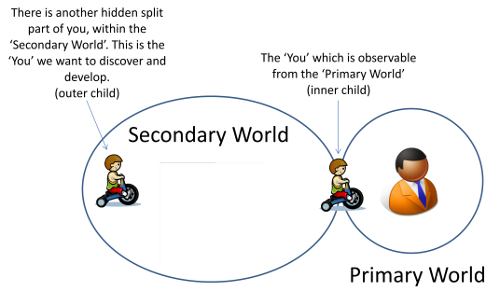Table of Contents
The Structure of Early Fragmentation
Introduction
During moments of trauma, we become fragmented. We are left with the sense of this Inner Child holding onto the boundary of their world. However within that world there is also another aspect of self, the Outer Child.
The Inner and Outer Child
The geography of the Primary World is such that there are two observer positions. The first position is defined as the you who you are in the here and now. From this position we can see in the real world and the Primary World concurrently.
The second observer position of this Primary World is usually located outside of the primary observer and can therefore be seen by the primary observer. This second observer represents half of an earlier you (the inner child) that was split off from an earlier Primary World. This part of us creates in his or her mind a metaphorical landscape or ‘psyche-scape’ that is better suited to the new real world conditions that exist after the defining moment.
The other half of this younger you (the outer child) remains encased in the prior Primary World, and cannot be seen from the primary observer position in the Primary World. This outer child is hidden in the Secondary World, and it is in the mind of this you who in that prior defining moment conceived the metaphorical landscape of the world you are currently in.
This is the you we want to re-connect with and bring back with us to the Primary World, to do this we have to go inside the Secondary World and develop and expand this world until this you is discovered and re-joined with the inner child.
Figure 6
Primitive Agonies of the Inner and Outer Child
There are some primitive agonies that our pristine self or early you experienced, depending on how safe and secure we were at this time. They are ways in which our early psyche splits and keeps itself safe. It is very possible that the you held back in a Secondary World can cause these experiences to continue into our adult life.
There are five primitive agonies, described in Donald Winnicott's research1):
- Going to pieces
- Falling forever
- Having no relation to the body
- Having no orientation
- Complete isolation, due to no means of communication
If a client is expressing symptoms similar to any of these, or their communication reflects a component of one, use this communication as the ‘signal’ and work with it, until it is able to free itself from its constraints.
Metaphorical Worlds < – Previous / Next –> Space
